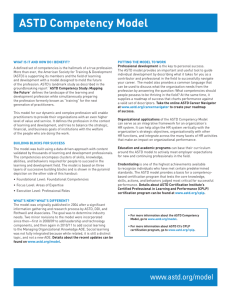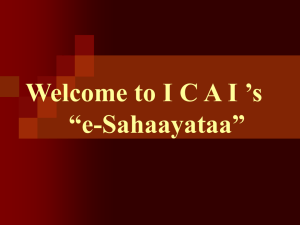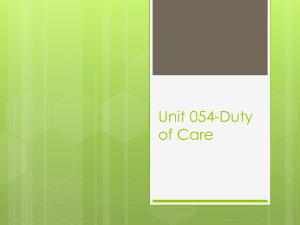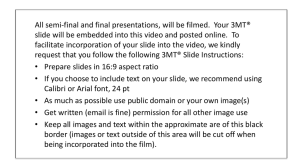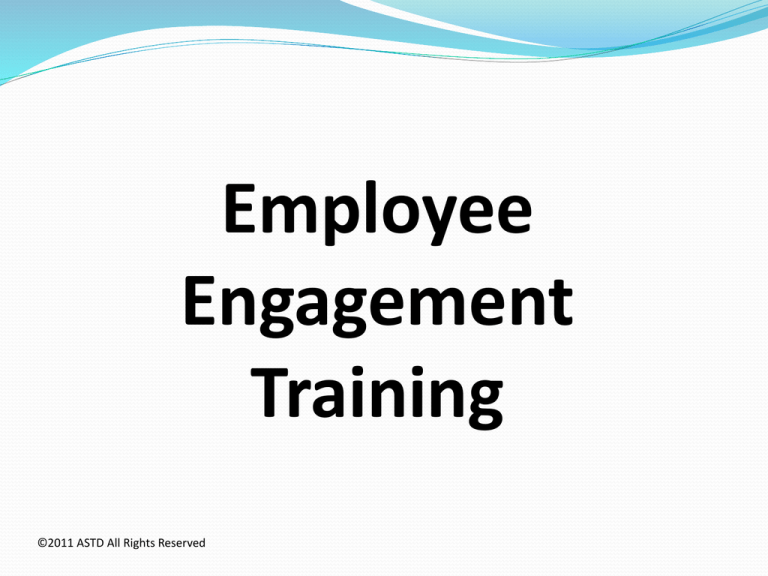
Employee
Engagement
Training
©2011 ASTD All Rights Reserved
Most problems at work
are a result of poor
communication.
©2011 ASTD All Rights Reserved
Communication is an Art,
Not a Science
There is no absolute right or wrong way to
communicate effectively. What is most
important is that you communicate in a
manner and style most comfortable and
effective for you.
©2011 ASTD All Rights Reserved
COACH’S COMMUNICATION MODEL
4. Acknowledges & accepts
2. Hears & responds
EMPLOYEE
1. Provides input on employee’s performance
3. Clarifies feedback
©2011 ASTD All Rights Reserved
COACH
5 Levels of Listening
Level 1—Tuned Out
Level 2—Distracted
Level 3—Selected
Level 4—Focused
Level 5—Engaged
©2011 ASTD All Rights Reserved
Listening Tips
Paraphrase the message to the speaker in order to
confirm your understanding.
Repeat the message to help you remember what was said.
Probe for missing information.
Remember the most important points of the message for
future application.
Act upon the message as necessary.
©2011 ASTD All Rights Reserved
Silent Messages
Often when we say nothing
we are actually saying a
great deal.
©2011 ASTD All Rights Reserved
Phrases That Kill Ideas
Don’t be ridiculous
It’ll cost too much
That’s not my responsibility
I don’t have time to talk about it
We’ve never done it before
If it ain’t broken don’t fix it?
We’re not ready for that
You can’t teach an old dog new tricks
We’ve tried that before
It can’t be done
It’s too big of a change
©2011 ASTD All Rights Reserved
Phrases That Kill Ideas (Cont.)
It’s not our problem
Let’s get back to reality
You’re getting ahead of yourself
It’s not in our budget
Let’s wait to decide
That doesn’t really apply to us
We have done alright without it
It won’t work in our business
That’s not the way we do things around here
©2011 ASTD All Rights Reserved
3 Levels of Coaching
Communication
Nice
Should
Must
©2011 ASTD All Rights Reserved
How True Are Rumors?
Studies have shown that forms of informal
communication such as the “grapevine” or “rumor mill”
are about 75% accurate at times. At first, this might
seem to be more accurate than expected. But just
imagine if all the information you received was only 75%
accurate. What if information you needed for an
important report to your boss was only 75% accurate?
Would that be acceptable?
©2011 ASTD All Rights Reserved
Effective Coaching
Is About Trust
©2011 ASTD All Rights Reserved
14 Commitments
of Effective Coaches
1. Provide orientation & training to new employees.
2. Maintain good working conditions.
3. Share business information.
4. Treat employees with respect.
5. Encourage employee involvement.
6. Establish written policies.
7. Promote cooperation throughout organization.
©2011 ASTD All Rights Reserved
14 Commitments
of Effective Coaches (Cont.)
8.
9.
10.
11.
12.
13.
14.
Resolve conflict in a positive manner.
Provide constructive discipline.
Ensure fair treatment for all employees.
Lead by example.
Address employee issues.
Provide performance feedback.
Help employees with personal problems.
©2011 ASTD All Rights Reserved
Basic Supervisory Principles
FIRM
Adhering to company policies and
procedures
Meeting job requirements
Insisting on job excellence
Expecting the best at all times
©2011 ASTD All Rights Reserved
Basic Supervisory Principles
FAIR
In using discretion with employees
In assigning work
In providing training and growth
opportunities
In promoting employees
©2011 ASTD All Rights Reserved
Basic Supervisory Principles
CONSISTENT
In applying rules and policies
In utilizing discipline
In setting a personal example
In your decision-making process
©2011 ASTD All Rights Reserved
Basic Supervisory Principles
RESPECTFUL
Treat everyone with dignity regardless of
the situation.
Listen, ask, explain.
Follow up with answers to questions.
©2011 ASTD All Rights Reserved
Engaged Coaching Model
More
Trust
Openness
Ownership
Versatility
Influence
Action
©2011 ASTD All Rights Reserved
Engaged Coaching Model
Less
©2011 ASTD All Rights Reserved
Control
Channels
Routine
Position power
Analysis
Bureaucracy
Following Directions Problem
Supervisor: Why did you do that job that way? This is not the way it was
supposed to turn out. Now we have to redo the entire job. This is a waste of
time and resources that was unnecessary.
Employee: I just did the job the way you told me to do it.
Supervisor: Ok, that’s true, but I didn’t realize at the time that there had
been changes made that caused these problems. Why didn’t you suggest that
we do this job a different way based on these changes?
Employee: You have told us that we also had to follow the standard
operating procedures without exception unless approved by you. You never
told me to do the job any other way, so I just followed the standard
procedures.
©2011 ASTD All Rights Reserved
Decisions are best
made by those closest
to the work.
©2011 ASTD All Rights Reserved
Helping Employees Contribute
Supervisor: Ann, I really like the way you worked on that last
project. You certainly showed a great deal of creativity and
imagination in completing the job. I never realized that you are so
creative!
Ann: Thanks, I really do like doing something when I can use my
imagination to come up with something different. I hope you can give
me other assignments in which I can utilize my creativity.
Supervisor: Now that I know how good you are at these kinds of
things, I will certainly assign these types of jobs to you in the future.
Ann: Great!
©2011 ASTD All Rights Reserved
Spending Time With Employees
What percentage of your working time do you spend
interacting directly with those who report to you? Draw
in a pie chart format what percentage you currently
spend in the circle below.
©2011 ASTD All Rights Reserved
Supervisor ASK/TELL Model
Mastery of
Job Tasks
Learning
Job Tasks
TELL
©2011 ASTD All Rights Reserved
Beginning
Job
ASK
Is Conflict
Always Bad?
©2011 ASTD All Rights Reserved
Causes of Conflict at Work
Miscommunication
The employee either did not receive the message or received only part of a
message, or the message was delivered in a way that may have been
misinterpreted.
Different Interpretations
The employee believes that adherence to rules, policies, or procedures
should be carried out in one way, while the actual intent or the rule, policy, or
procedure is something else entirely.
Different Values
The employee has less regard than others for a specific task or duty and
does not attach importance to its value.
Opposing Goals
The goals of the company or supervisor are directly opposed to those of
the employee.
©2011 ASTD All Rights Reserved
Conflict Strategies
Win/Win—Collaboration
Both parties achieve their goals
o Example: Working together, an acceptable resolution is
reached that helps everyone concerned regarding a
conflict.
Win/Lose—Competition
One person is defeated
Example: Employee’s request or complaint is denied
without reason.
©2011 ASTD All Rights Reserved
Conflict Strategies (Cont.)
Lose/Lose—Avoidance
Neither party achieves its goals.
Example: Employee quits because of perceived problems at
work.
Lose/Win—Give in
One person gives in.
Example: Supervisor not enforcing rules.
©2011 ASTD All Rights Reserved
Conflict Management Matrix
+
A
S
S
E
R
T
I
V
E
N
E
S
S
__
Reject
Confront
Cooperate
Resist
Judge
Negotiate
Retreat
Ignore
Give in
__
©2011 ASTD All Rights Reserved
I NVOLVEMENT
+
Conflict Comfort Zone Matrix
©2011 ASTD All Rights Reserved
Definition of a Complaint
A complaint is any condition an employee thinks
or feels is unjust or inequitable from her
perspective. Even though a complaint may be
seen from a very different perspective by other
people (including yourself), this does not diminish
the importance of it to the person who has the
complaint.
©2011 ASTD All Rights Reserved
Complaint Handling Steps
6. Follow up
5. Take action
4. Decide
3. Investigate
2. Get story straight
1. Listen
©2011 ASTD All Rights Reserved
“Is it good if a supervisor
doesn’t hear or receive
any complaints?”
©2011 ASTD All Rights Reserved
NO!
The supervisor may have walled herself away from
employees, become too easygoing, too firm, been
impatient with complaints that seemed unjustified,
retaliated against a complainer in the past, not acted upon
the complaints, or for many other reasons.
©2011 ASTD All Rights Reserved
Employees’ Reactions to
Unsettled Complaints
What can the employee do?
Adjust
Complain
Take action
Worry or brood
Who can employees turn to?
Help outside of company such as a government agency
Legal system
Within company
©2011 ASTD All Rights Reserved
Passing a Complaint on UP
Why might a supervisor hesitate to refer a
complaint to the next level?
Why should a complaint be referred to a
higher level?
Why do employees want a complaint to go
higher?
©2011 ASTD All Rights Reserved
A coach’s goal in dealing with an
employee’s complaint should be to
address the person’s issue in the best
and most appropriate manner
possible—not “win” the complaint.
©2011 ASTD All Rights Reserved
Reasons for Poor Performance
Lack of communication
Lack of conditions
Lack of consequences
©2011 ASTD All Rights Reserved
5-Step Performance–
Correction Process
Step 1—Observe
Step 2—Discuss
Step 3—Correct
Step 4—Advise
Step 5—Confirm
©2011 ASTD All Rights Reserved
2 Basic Rules About
Managing Performance
1. Always expect excellent
performance.
2. Never let poor work go unnoticed or
performance issues go unchallenged.
The 5 Ws of Documentation
Who is going to see this?
What will I or someone else want to know about this
event in the future?
Why will I want to look at this again?
When do I write or document this event?
Where will I keep this document?
©2011 ASTD All Rights Reserved
Reasons for Performance
Problems
©2011 ASTD All Rights Reserved
Job fit
Motivation
Ability
Training
Job itself
Supervision
Levels of Feedback
None at all
Negative only
Positive only
Balanced
©2011 ASTD All Rights Reserved
The Default Performance
Feedback System
“If you don’t hear anything, you
are doing just fine but if you screw
up we’ll let you know!”
©2011 ASTD All Rights Reserved
Types of Feedback
Formal—documented
annual/semiannual performance review
Informal—day-to-day communication
and feedback about performance
©2011 ASTD All Rights Reserved
Coaching Performance Tips
1. Observe and assess the specific job performance behavior(s) of an
employee.
2. Decide if it is effective or ineffective job performance.
3. If it is effective behavior:
Point out what is effective about the behavior.
Explain why it should be continued and the benefits of doing the job right.
Praise or compliment the employee for this effective behavior as
appropriate.
4. If it is ineffective behavior:
Tell the employee to stop the behavior and explain why it is ineffective.
Explain what an alternative behavior would be and why alternative
behavior would be better.
5. Reinforce the correct behavior when observed in future.
©2011 ASTD All Rights Reserved
Potential Reinforcers
__Letter of commendation
__Gift certificate
__Asking for advice
__Plaque or trophy
__Reporting results
__Clothing, hat, etc. with company logo
__Decision making
__Free lunch
__Note about good performance
__Training
__Passing on compliments
__Special projects
__Choice of tasks
__Cup of coffee
__Less supervision
__More work
__Represent group at meeting
__ Thank-you phone call
__Free parking or personal parking space
©2011 ASTD All Rights Reserved
Deciding When Teams Can
Be Most Effective
When teamwork can unblock creativity
When there is no obvious solution
When team decision-making is most
effective
When there is a willingness to accept the
team’s recommendations
©2011 ASTD All Rights Reserved
Definition of Consensus
“This decision was not my idea or even my
first choice concerning the decision of the
team, but I do agree to support and work
toward the success of this decision just as
if it were my own.”
©2011 ASTD All Rights Reserved
Synergy
Synergy is the blending of different human skills,
talents, and experience to produce a total effect
greater than the sum of the individual team
members’ skills, talents, and experiences alone.
With synergy 5 + 5 = > 10.
©2011 ASTD All Rights Reserved
Team Leader’s Responsibilities
Train team members to work together
Identify potential obstacles
Suggest procedures or ideas for solving a problem
Help get information
Give input
Help the team progress
Monitor progress
Recognize and reward results
©2011 ASTD All Rights Reserved
Types of Difficult Team
Members
The reluctant team member
The defiant team member
The dominant team member
The absentee team member
The vacationer team member
©2011 ASTD All Rights Reserved
Characteristics of an Engaged
Team Player
1. Openly shares feelings, opinions, thoughts, and
2.
3.
4.
5.
perceptions about problems and issues relating to the
team.
When listening, attempts to hear and interpret
communication from sender’s point of view.
Utilizes resources, ideas and suggestions of other team
members.
Trusts and supports other team members, encouraging
their growth and development.
Understands and is committed to team objectives.
©2011 ASTD All Rights Reserved
Characteristics of an Engaged
Team Player (Cont.)
6. Acknowledges and works through conflict openly, by
respecting and being tolerant of individual differences.
7. Makes decisions based on information only, rather than
being influenced by peer pressure.
8. Provides ideas and suggestions to the team leader that
are helpful to the team.
9. Always strives for a win/win solution.
10. Strives for consensus on team decisions.
©2011 ASTD All Rights Reserved
Project Plan Example
Goal
1.
2.
3.
4.
5.
6.
7.
8.
9.
10
©2011 ASTD All Rights Reserved
Team
Member(s)
Responsible
Deliverable
Measure
Due
Date
Status
Completed Project Plan
Team Project: Develop Customer Survey on New Product
Goal
Team
Member(s)
Responsible
Deliverable
Measure
Due Date
Status
1.
Design customer
survey on proposed
new product
Steve Smith
Kathy Brown
Design survey for
team’s approval
Team’s agreement
on survey
design
3/1
First
draft
presented
3/1
2.
Meet with
Marketing
Dept. on
survey plan
Steve Smith
Final survey
presented
to Marketing
Department
Marketing
Dept’s
approval of survey
3/15
Survey
approved
Send survey to
customers
Angela Craig
Identify customers to
participate in survey
and send to them
Customers
receive survey
before new season
beginning in May
4/1
3.
Kevin Jones
Benita King
3/7
Surveys
sent out
3/21
4.
Analyze
survey data
Kevin Young
Review and analyze
data from survey
results
Develop report on
customer response
to changes
5/15
Report
developed before
5/15
5.
Recommend
actions
based on
survey
results
Kevin Jones
Kathy Brown
Propose response to
customer feedback
based on data analysis
Present
plan based on
customer
response
to Marketing Dept.
5/22
Meeting
held
with
Marketing
Dept 5/20
6.
Implement
actions
Angela Craig
Develop
implementation plan
Implement plan
6/1
Plan implemented
6/1
7.
Evaluate
results
Benita King
John Black
Collect data
concerning implementation plan
Develop
implementation
report
7/1
Report
completed
6/25
8.
Present results to
VP Marketing
Prepare
presentation for VP
Presentation to VP
of
Marketing
7/15
Meeting
scheduled
7/15
©2011 ASTD All Rights Reserved
All

